Key takeaways:
- Rapport in education is vital for establishing trust, enhancing engagement, and creating a supportive learning environment for students.
- Personalizing interactions by understanding students’ interests and backgrounds significantly boosts motivation and fosters connections.
- Effective communication techniques, such as active listening and maintaining eye contact, are crucial for building rapport and encouraging student participation.
- Continuous reflection on rapport-building strategies is essential for improving teaching effectiveness and nurturing student relationships over time.
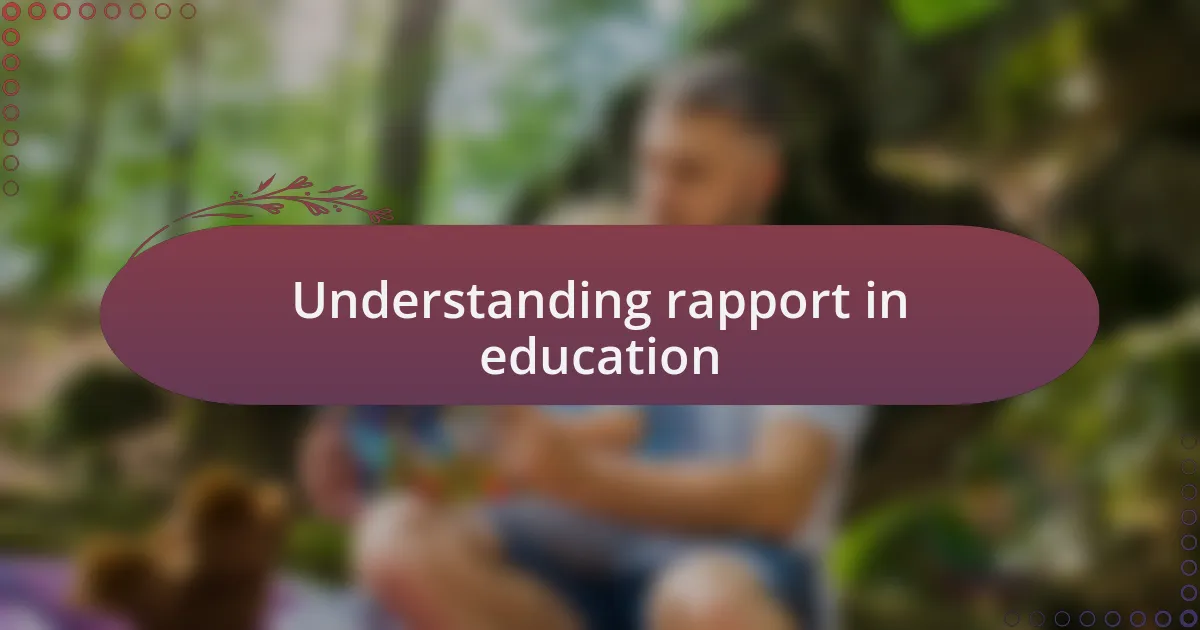
Understanding rapport in education
Rapport in education is more than just a friendly atmosphere; it establishes a foundation of trust and understanding between teachers and students. I remember a time when I took an extra moment to listen to a student’s concerns about a group project. That simple act sparked a deeper connection, allowing me to support not just academically but emotionally, emphasizing the importance of genuinely valuing students’ voices.
Building rapport allows students to feel comfortable expressing themselves, which can significantly enhance their willingness to engage in class. Think about it: have you ever noticed how students contribute more when they feel seen and heard? This realization guides my interactions, reinforcing my belief that fostering a supportive environment is essential for effective learning.
Emotional investment is a key player in developing rapport; I have seen how sharing my own experiences and challenges opens the door for students to do the same. When I shared my struggles with a math problem during my own schooling, it was almost magical to watch the students’ expressions shift. They connected with me, realizing that vulnerability can facilitate collaboration and eagerness to learn together.

Importance of building rapport
Building rapport is essential because it fosters a safe learning environment where students feel valued and respected. I recall a student who initially struggled to participate in discussions. By taking the time to understand his interests, I was able to relate class topics to his passions, which ignited his enthusiasm. Isn’t it fascinating how connecting on a personal level can spark motivation and drive engagement?
The impact of rapport extends beyond the classroom; it nurtures a sense of belonging. I often notice that when students feel a connection with their teacher, they are more likely to support each other. Have you ever witnessed a group of students rally around a classmate during a tough project? Their collaboration often stems from the trust established between them and the teacher, creating a ripple effect that enhances the overall learning experience.
Moreover, building rapport can significantly reduce anxiety and create resilience in students. I remember one student, visibly nervous before presentations, transform into a confident speaker after we spent time practicing together. This not only boosted her self-esteem but also showed her that support is always available. How many times do we underestimate the power of simply being there for someone? This emotional connection can truly make a difference in a student’s journey.
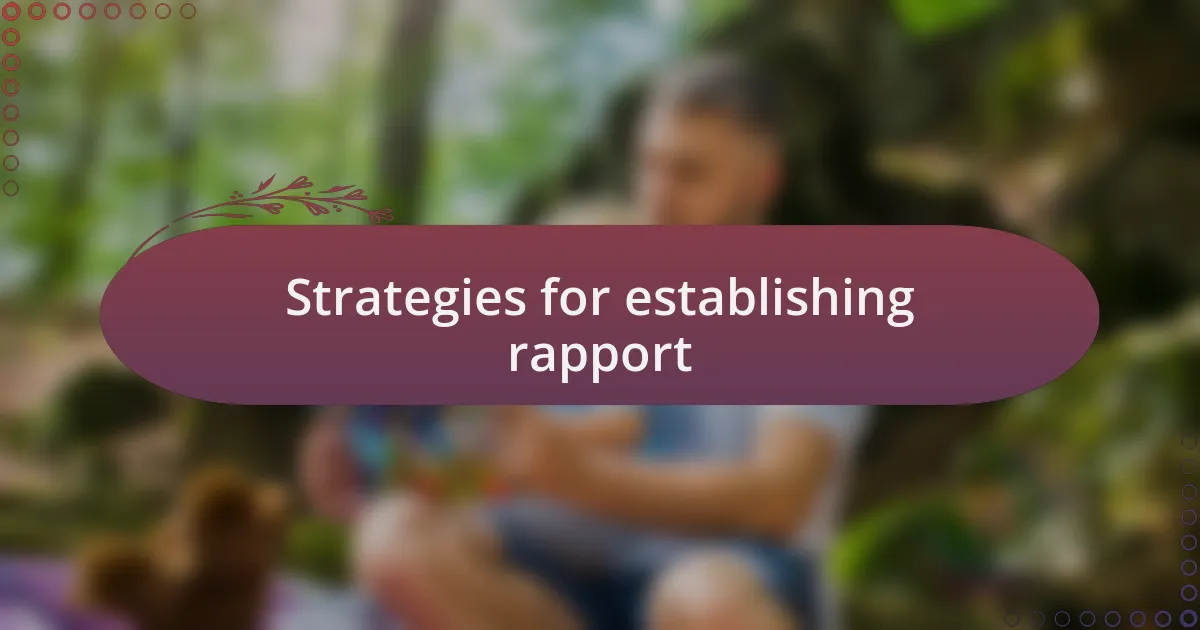
Strategies for establishing rapport
One effective strategy for establishing rapport is to actively listen to students. I remember one particular instance when a student shared a personal story that was unrelated to class material. By mirroring her emotions and showing genuine interest, I could create a safe space for her to express herself. How often do we take the time to truly listen? It can change everything.
Another approach I’ve found valuable is incorporating humor into lessons. I once made a light-hearted joke about a challenging math problem. The resulting laughter not only eased tension but also created a more relaxed atmosphere. When students see their teacher as approachable and fun, they are more likely to engage in discussions. Isn’t it wonderful how a simple laugh can break down barriers?
Lastly, sharing my own experiences and vulnerabilities can also help in building that essential connection. I once spoke candidly about my own academic struggles, which encouraged students to open up about theirs. This act of sharing can foster an environment of trust and encourage empathy among classmates. Aren’t we all looking for a little understanding in our educational journeys?
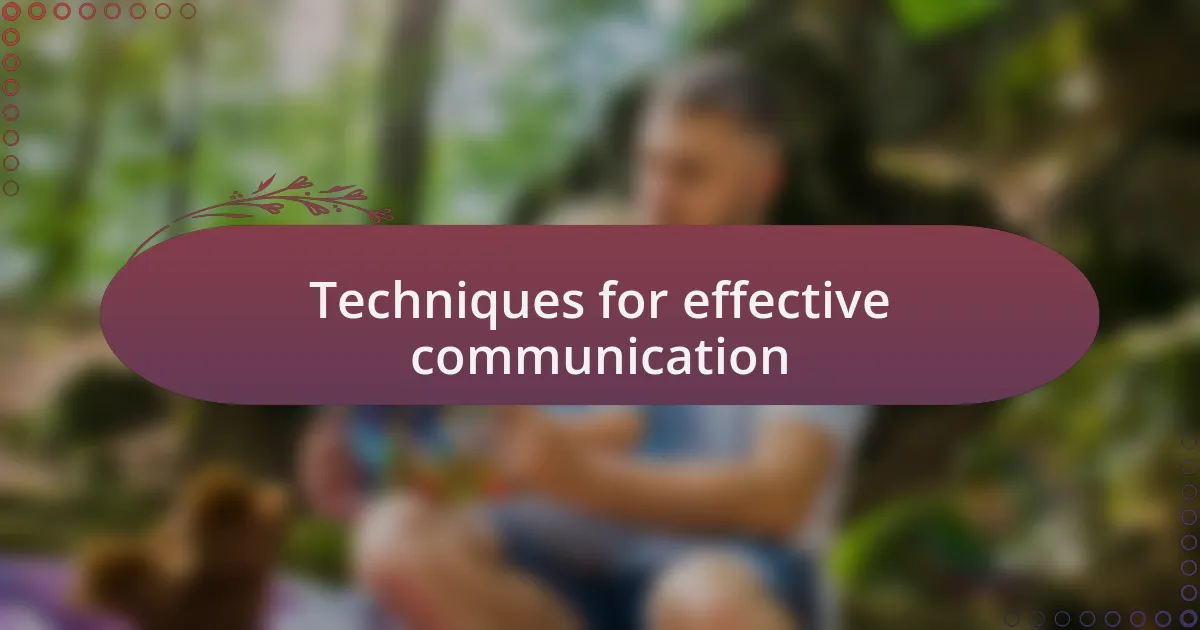
Techniques for effective communication
Effective communication is foundational in building rapport with students. I find that using open-ended questions encourages students to express their thoughts more freely. For example, during a group discussion, I often ask, “What are your thoughts on this topic?” I’ve noticed that this not only invites diverse opinions but also makes students feel valued and engaged. It’s amazing how a simple question can spark a lively conversation.
Another technique that resonates well with my students is maintaining eye contact. I recall one moment in class when I locked eyes with a student who seemed hesitant to speak up. I gave a slight nod, signaling that their voice mattered. That small gesture transformed the atmosphere, prompting them to share their ideas. Have you ever noticed how reassuring it can be to feel seen and heard?
Additionally, I find that adapting my communication style to meet the needs of individual students is crucial. I remember working with a student who struggled with written instructions. By using clearer language and breaking tasks into smaller steps, I noticed their confidence soar. It made me realize that adjusting our approach can open doors to understanding. Isn’t it incredible how tailored communication can lead to genuine connections?
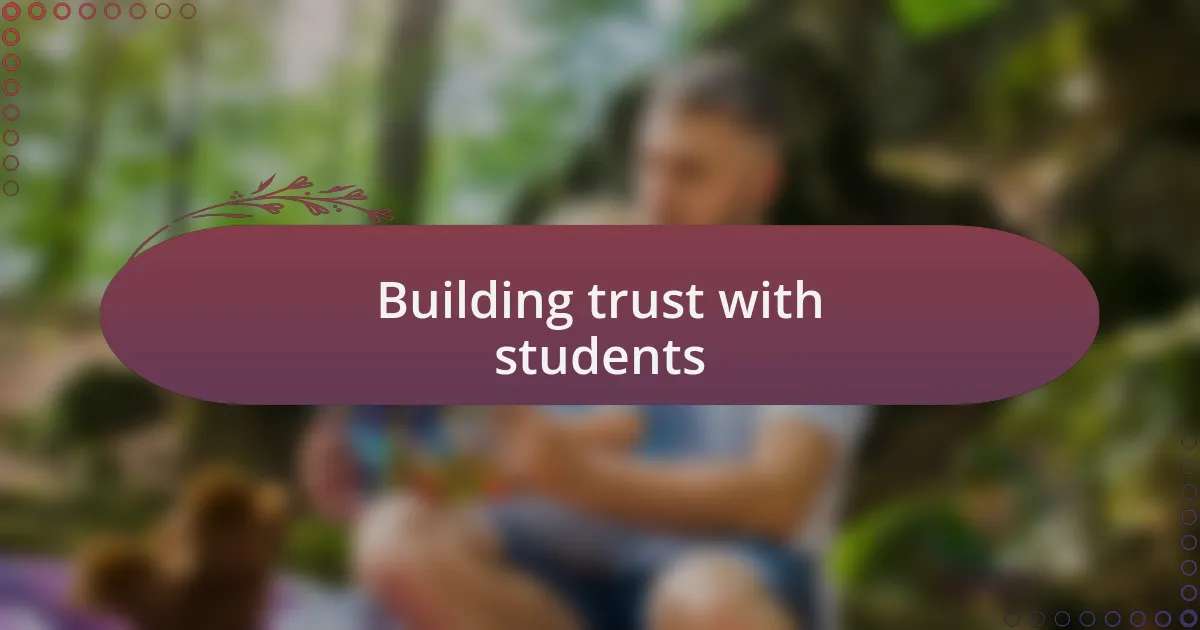
Building trust with students
Building trust with students is a gradual process that I’ve learned requires consistency and honesty. In my experience, sharing a bit about my own challenges and mistakes fosters a sense of authenticity. I once opened up about a personal hurdle I faced as a student, revealing how it shaped my learning journey. This vulnerability encouraged my students to share their own struggles, and I realized that when they see me as a human, the walls of distrust begin to crumble.
I also prioritize creating a safe space for my students to express their thoughts and feelings. I remember a time when a student felt comfortable enough to confide in me about their anxiety regarding school. Responding with empathy rather than dismissal deepened our bond and built trust. It made me reflect on how crucial it is to listen actively and validate their emotions. Has a student’s trust ever surprised you with its depth?
Moreover, I find that being reliable and following through on commitments reinforces trust. There was an occasion when I promised to check on a student’s progress after a challenging assignment. When I followed up, not only was their surprise evident, but it also solidified our connection. It’s in those small, consistent actions that students begin to feel secure in our relationship, knowing I genuinely care about their success.
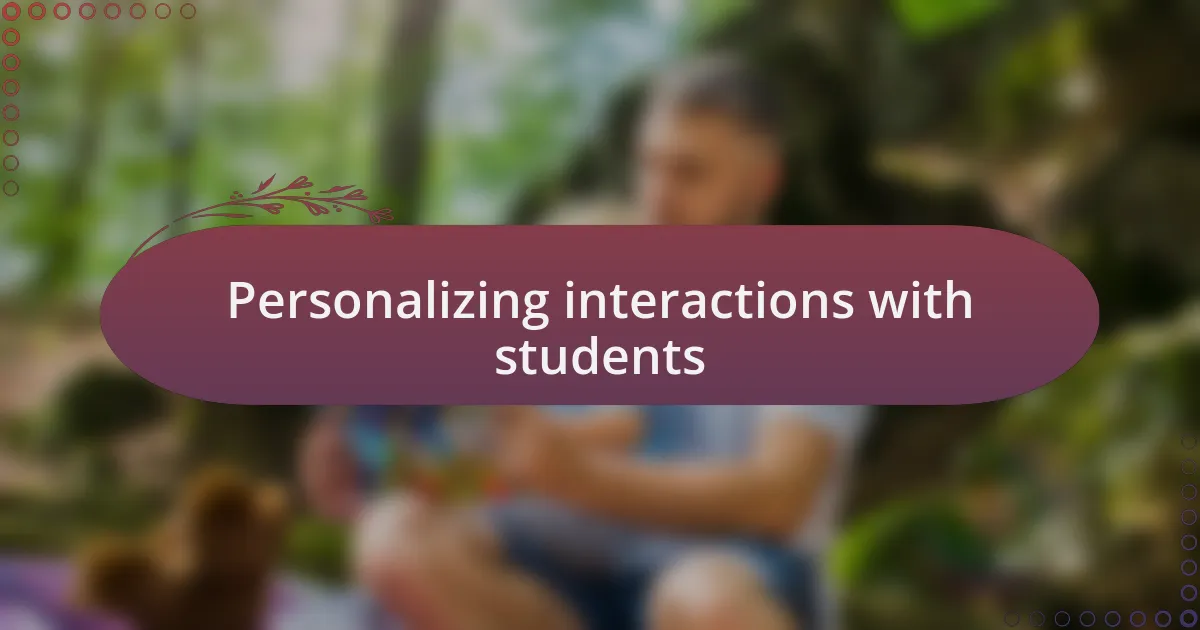
Personalizing interactions with students
When I personalize interactions with students, I aim to see them as unique individuals with their own stories. I recall one student who loved astronomy. To connect with him, I incorporated space themes into our lessons. His eyes lit up during class discussions, and it was a reminder of how tailored approaches can ignite passion and engagement. How often do we overlook a student’s interests when we create lesson plans?
Understanding each student’s personal background is equally essential. I once discovered a student was working a part-time job to support their family. This knowledge shifted how I approached our interactions; I made an effort to ask about their workload and adapt deadlines when necessary. The gratitude in their smile revealed just how much acknowledgment really matters. Have you ever considered how knowing a student’s struggle could transform your support for them?
Additionally, I strive to create moments of genuine connection in the classroom. Just last week, I took a few minutes to chat with a student about their favorite book series. That small conversation turned into a spirited discussion and invited other students to join in. It taught me that these personalized interactions make students feel valued and included. Doesn’t that sense of belonging enhance their learning experience?
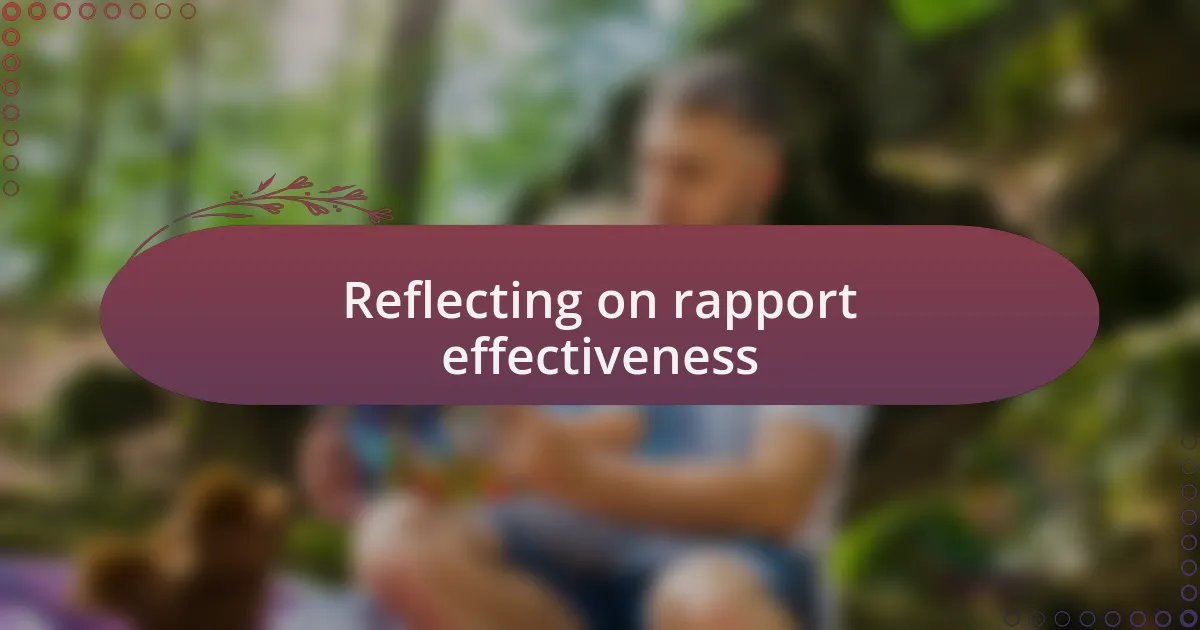
Reflecting on rapport effectiveness
Reflecting on the effectiveness of rapport-building is crucial for continuous improvement. I remember a particular lesson where I noticed a dip in engagement among some students. After the class, I took time to reflect and realized that while I was enthusiastic about the topic, I hadn’t connected it to their lives. This insight reminded me that effective rapport isn’t just about being friendly; it’s also about being relevant. How often do we forget to link our lessons to what truly matters to our students?
Another instance that stands out is a feedback session after a group project. I encouraged students to share what worked well in our collaboration and what could be improved. Their honest responses not only guided my teaching strategies but also deepened our connection. It became clear that when students feel heard, their investment in the classroom experience skyrockets. Have you ever considered how feedback invites students to play an active role in shaping their learning environment?
Sometimes, the impact of rapport is immediate, yet it can also unfold over time. I had a student who struggled initially but began to engage more after I consistently checked in with them. Over months, I witnessed a transformation: they became a leader in group projects. This journey highlighted how building rapport is an ongoing process, not just a one-time effort. It’s essential to ask ourselves: are we nurturing these connections consistently?